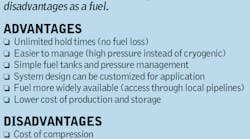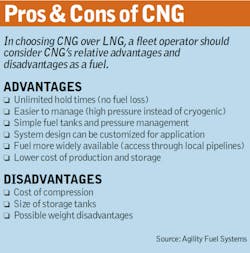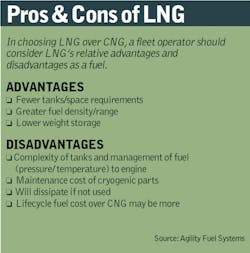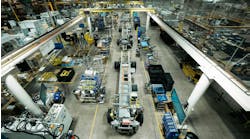Is natural gas just too good to be true? That’s what trucking companies large and small are asking themselves as they weigh the costs associated with switching to either compressed natural gas (CNG) or liquefied natural gas (LNG) against the ever-rising price of diesel fuel, which has hovered above the $4/gal. mark since late February of this year.
Trucking is no stranger to the natural gas pitch (nor the pitch makers themselves), of course, as the industry has pondered this particular alternative fuel pathway many times in the past. Since at least 1988, proponents of the fuel source have urged truckers large and small to switch over to natural gas.
“[Gasoline and diesel] prices are spiking. Again. And again the public is concerned,” wrote T. Boone Pickens, founder & chairman of BP Capital Management and a long-time advocate of using natural gas to fuel transportation needs in the U.S., in an op-ed in the Orlando Sentinel last month.
“Like the 1993 movie Groundhog Day with Bill Murray, we wake up every couple of years and go through exactly the same sequence of events with exactly the same results,” he said. “Put simply, we have little say in the price of oil. It’s a global commodity.”
Today, Pickens added, the U.S. finds itself the world’s “oil police” as well, which adds significantly to the nation’s cost in importing some 43% of the oil it consumes every day.
“There are 11 U.S. carriers [positioned] outside of U.S. coastal waters. There are more deployed in the Middle East — to protect oil supplies — than anywhere else,” he pointed out. “If you factor in those costs, the U.S. has spent $7 trillion on OPEC [Organization of Petroleum Exporting Countries] oil since 1976. It’s fiscal and economic insanity.”
Pickens added that any national alternative energy plan, however, must have transportation as its central focus for it accounts for two-thirds of total oil use in the U.S.
“I have been—and remain—a staunch advocate of renewable energy, including wind and solar, as part of the long-term energy mix. But those are power-generation fuels,” he stressed. “Transportation—replacing dirtier, expensive OPEC crude with cleaner domestic fuels — is the way to go. And on that front, all roads lead to natural gas.”
That’s easier said than done, however, due to the significant upfront cost to switch trucking operations from diesel to natural gas—a cost that has remained the major stumbling block for natural gas boosters like Pickens, who himself has publicly advocated for this switch and who has a 30% ownership stake in natural gas fuel provider Clean Energy through BP Capital.
A recent report by global consulting firm Frost & Sullivan, entitled “Strategic Analysis of the North American Class 6-8 Natural Gas Truck Market,” found that the per-unit premiums for spark-ignited CNG and LNG trucks were $29,750 and $27,750, respectively, with the compression ignition heavy-duty engine systems running on 95% LNG and 5% diesel to power over-the-road Class 8 models costing $72,450 more on average than a comparable diesel-powered unit.
That steep up-front cost is one reason the number of natural gas-powered trucks in the medium- and heavy-duty commercial trucking segment will grow slowly, the firm said, from 1,950 units today to over 29,483 units in 2017, making up just 8% of total Class 6-8 production six years from now.
That’s why many believe the only way to make natural gas truly work in trucking operations is to view it as a “longterm play.”
Kelly Mills, western U.S. territory sales manager for natural gas engine maker Westport Innovations, pointed out that fleets spec’ing his company’s 15L LNG-fired product are going to lose money during the first year or two of their truck ownership cycle, largely because of the $80,000 more a fleet will have to pay for a Class 8 truck equipped with Westport’s GX heavy-duty engine versus a traditional diesel-powered model.
“But that all changes in year three and beyond of the ownership cycle,” he stressed, for that’s when the fuel price differential between natural gas and diesel fuel begins to fall to the bottom line.
A leasing plan
Right now, natural gas costs about $2.50 per diesel gallon equivalent (DGE) compared to diesel fuel, which is now averaging $4/ gal. “That equates to a fuel savings of $20,000 to $40,000 per year, depending on your annual truck mileage,” he said. While a variety of tax credits over the years have helped fleets reduce the initial premium for natural gas-powered trucks, they don’t completely eliminate it, thus creating long payback periods that often don’t make fiscal sense in the low margin business of trucking.
To try and change that, truck maker Navistar and Clean Energy aim to alleviate that initial cost burden through a unique leasing plan they plan to roll out for the industry in 2013. This business plan will require fleet customers to buy natural gas fuel under contract from Clean Energy for a set period of years as well as lease natural gas-powered trucks from Navistar. In return, fleets avoid paying the often fivefigure premium charged for natural gas-powered trucks versus their diesel-powered brethren, says Jim Hebe, Navistar’s senior vice president-North American sales operations. Even after accounting for the cost of the contracted fuel price and truck leases under the program, Hebe contends that fleets should still recoup savings from the lower cost of natural gas versus diesel on the order of 50 to 70 cents per gallon.
“We came to realize we needed to mitigate four major barriers to the wider adoption of natural gas as a transportation fuel: the lack of a national refueling infrastructure, adequate availability of natural gas-powered technology, sustainable cost differences between natural gas and diesel, and the affordability of natural gas-powered trucks,” Hebe says. “This alliance addresses all of those issues.”
Andrew Littlefair, president & CEO of Clean Energy, adds that his company plans to build 70 LNG refueling stations along major highway corridors in the U.S. this year and another 100 facilities in 2013; roughly a $200 million investment that should help solve the “where am I going to get fuel?” issue faced by truckers.
He added that Clean Energy plans to add 100 to 150 locations annually to provide both LNG and CNG over the next five years should demand increase.
Hebe notes that Navistar’s medium-duty DuraStar and WorkStar chassis will be available with a natural gas-fired MaxxForce DT engine by the end of the first quarter this year, with its TranStar model available with a Cummins ISL G natural gas engine ready for deployment by mid-2012. By the start of 2013, Navistar plans to roll out a ProStar tractor equipped with a MaxxForce 13L diesel pilot injected natural gas engine, followed by a PayStar natural gas model.
The spread matters
Hebe says Navistar’s 13L engine-equipped tractors should offer equivalent horsepower and torque ratings to diesel-powered models and be capable of traveling between 400 and 650 mi. with either 80 or 100 equivalent- gallons worth of LNG on board, configurations that should add only 100 extra lbs. of weight to the vehicle.
Looking long term is also critical in terms of gauging the cost of future fuel supply as well, notes David Jaskolski, senior account manager for Southeast LNG, a transportation- focused division of natural gas supplier AGL Resources.
“It’s not just what the equivalent gallon price of natural gas is on any given day; it’s the spread between natural gas and oil futures that’s important,” he explains.
Oil is traded on the global market and is subject to many different pricing pressures, not all of them supply-and-demand related, Jaskolski points out. “However, the bulk of the natural gas U.S. transportation would rely upon is in North America,” with 87% of it coming from the U.S. and another 12% from Canada.
That “stranded” domestic supply means natural gas prices are much less volatile and would be able to sustain a significant pricing spread that would benefit users when compared to oil, Jaskolski explains.
“Even if significant exports of LNG were to occur from the U.S. to the world market, it would not affect that [pricing] spread,” he says.
That’s why many truck makers are focusing more dollars on developing natural gas-fired products. Robert Woodall, Peterbilt Motors Co.’s director of sales and marketing, says his company “is investing millions” to widen its natural gaspowered truck offerings, with plans to build 2,000 trucks powered by CNG or LNG by the end of this year. He also notes that 100% of the natural gas trucks Peterbilt builds will have factory-installed fuel systems.
“Our parent company Paccar has invested $2 billion over the past two years in new products, facilities, and technology, and that includes alternative fuel technology,” he adds. “That’s part of our overall effort to drive down the cost of operations for our customers.” “We’re finding that natural gas has a certain place when it comes to heavy-truck operations,” adds Ryan Carmichael, a transportation analyst with Frost & Sullivan.
“We’re finding it’s a particularly good fit for regional fleets, port freight facilities, and especially refuse operations. The price advantage of natural gas versus diesel in these specific segments is what will be the storyline here.”W hat’s also going to be part of that storyline is that a wider array of natural gas engine and truck options, especially on the heavy-duty side of trucking’s ledger book, are coming to market now or within a year or two. That will create more competition, which should help drive product prices down, notes Carmichael.
For example, Cummins Westport, a 50/50 joint venture between Cummins Engine Co. and Westport Innovations, recently began field trials of its new ISX12 G natural gas engine, based on the Cummins ISX12 diesel engine platform, with full production expected in 2013. Designed for North American regional haul and vocational truck/tractor, plus refuse applications, the ISX12 G uses a lower-cost, spark-ignited combustion with cooled exhaust gas recirculation and can operate on either CNG or LNG, which should help reduce the return on investment cycle for those kinds of fleets. “Right now, at the current differential between natural gas and diesel prices, we’re looking at a two- to three-year payback period for the spark-ignited style of natural gas propulsion technology,” Carmichael explains. “As most regional operators keep their vehicles anywhere from eight to 10 years, that payback period creates a strong strategic benefit for them.”
“The reality is that high diesel prices and evolving environmental rules are leading truck operators to seek practical solutions when it comes to their truck purchases,” says Andy Douglas, Kenworth Truck Co.’s national sales manager. “Natural gas pricing has decoupled from oil pricing and we are producing more than we can use, so transportation represents a good emerging market for natural gas producers. We have also had many real-world successes with natural gas in fleet operations, and it shares 80 to 90% of diesel engine technology, so it is not really shifting the paradigm that much. It works in our world.”





